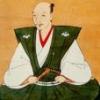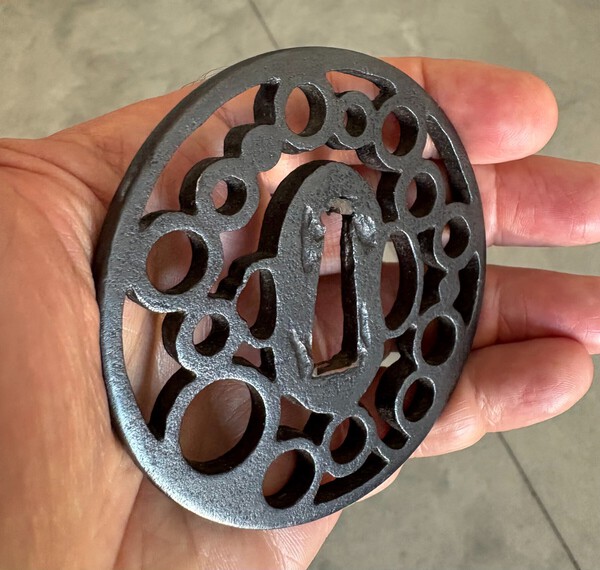-
Posts
962 -
Joined
-
Last visited
-
Days Won
4
Content Type
Profiles
Forums
Events
Store
Downloads
Gallery
Everything posted by Steve Waszak
-
A few more from my friend's collection. I am presenting these as two pairs of tsuba. Pair 1: The first tsuba here features a triple tomoe motif, and measures 7.9cm x 7.7cm x 3mm. The second piece has a motif of what looks to be kiri with blossoms, together with a lattice design. 7.5cm x 5mm. Pair 2: The first tsuba in this pair presents with a large "dancing-kiri"-with-blossoms motif. Shakudo inserts. 7.8 x 7.7 x 5mm. The second tsuba also features a kiri motif with a strongly rounded rim. 7.2cm x 4mm. Each pair is $240.00. For all four tsuba, $400.00, plus shipping.
-
The third group (three iron sukashi tsuba, no inlay) has SOLD. Additionally, the first two groups of three tsuba are reduced to $185.00 plus shipping, each.
-
Okay, guys, up for today are three groups of sword guards from my friend's collection. These are meant to move quickly, and so are listed with asking prices that are quite low. In each group, there are three tsuba, so, a total of nine in all. I am not providing details regarding dimensions, motif features, possible "schools" or traditions with each of them, but if anyone has a question about such information about a specific piece, please reach out to me and I'll try to provide an answer. The prices for these will work like this: each group of three tsuba is $285; six together (two groups) would be discounted to $540; and all nine would be $765. All excluding shipping, of course.
-

Increasing Gold Membership numbers?
Steve Waszak replied to Brian's topic in General Nihonto Related Discussion
Just subscribed. -
Up next is what I believe to be an early (ko?) Akasaka tsuba. I base this both on the very small kogai-ana (something I believe the earliest Akasaka smith[s] employed) and on the less-than-usually-rounded rim. The rim has rounding to it, but not in full maru form. The boldness of the guard also is in keeping with Akasaka sensibilities: the powerful rendering of the sukashi (nothing filigree here!) is reminiscent of Owari sukashi aesthetics, which, again, is something we see in early-Akasaka work. The motif here is challenging to decipher. At first, I thought the tsuba might be depicting a group of gourds, but I am far from confident in that interpretation. In any event, the sheer strength of the tsuba in its forms and construction is impressive. The seppa-dai is very well formed, too. Note that at about 2:00 on the omote, there appears to be a kirikomi/delamination; this does not continue all the way through the rim. The tsuba is in excellent condition overall, and comes in a custom fitted box. It measures 7.7cm x 4mm. $950.00, plus shipping.
-
Tsuba #1 has been SOLD.
-
Glad it arrived safely, Dieter.
-
Hard to pick an absolute favorite, but this is on the short list -- a low-crossbar Yamakichibei work from late-Momoyama.
- 40 replies
-
- 12
-

-

-
Tsuba #2 has been SOLD.
-
The second tsuba is not papered, but I believe this, too, is Shoami. Ko-Shoami? I can't be certain. It's primary feature is the pleasing crispness with which it has been carved. This effect is aided by its dimensions: while only 7 cm x 6.8 cm in size, it is also 5 mm thick, allowing a discernible depth to be achieved. This tsuba's motif is a collection of mon, sequenced among carved bamboo shoots at the cardinal positions. The condition is excellent, the iron punctuated by light tekkotsu scattered along the rim. A very elegant piece. Comes in a custom, fitted box. $375.00 plus shipping.
-
Up next from my friend's collection are two iron ji-sukashi pieces. The first is papered to "Myochin," though I suspect ko-Shoami might be the better attribution. This is a pretty dynamic sword guard. It measures 8 cm x 7.9 cm x 4 mm, and features a particularly expressive triple-tomoe motif. The iron is very good, presenting with a soft, natural patina and fine color. The lone hitsu-ana is very well formed, as is the massive seppa-dai. There are a few small tekkotsu in the rim, along with one very large one. These latter details combine to have me leaning more toward ko-Shoami than toward Myochin, though the fact that the shinsa team assigned a Myochin attribution to this tsuba may indicate something about its powerful presence. $400.00 plus shipping (PayPal friends and family preferred).
-
I'll be posting more this weekend, if not sooner!
-
Right there with you, Curran. This Juyo Rabbits tsuba has long been one of my absolute favorites, by any smith, and may be my #1 Hoan work (which is saying something). Hoan is not often mentioned in the same breath as Nobuiye, Kaneie, Myoju, and Matashichi, but certainly should be in my view, along with Yamakichibei, of course.
-
Up next from my friend's collection is an NBTHK-papered Heianjo-zogan iron tsuba. It features high-relief brass inlay depicting an active landscape scene, with dragons as a chief component. A lot going on in this composition. The hitsu-ana are irregularly shaped, and are plugged with what looks to be textured shakudo. The tsuba is in very good condition, and measures 7.6cm x 7.8cm x 4mm. $185.00 plus shipping.
-
Hi Florian, You make some good points here, especially about the Hoan smiths making their works for the Asano family (and perhaps for other high-ranking clans), but not for the masses. For some of the most highly regarded tsubako (e.g. Hoan, Nobuiye, Yamakichibei, and the Higo smiths), they were indeed retained by Buke families, and did not, as far as I know, make their works availably broadly and generally to the public in common commerce. I believe this was true of the Akao as well. As retained craftsmen, they received a stipend, thus removing the need (and, perhaps, the permission) to sell their tsuba to the masses. As for the 10-koku stipend the Shodai was provided by the Asano, while some may see this amount as meager, it may not actually be so. We may need more information about the particular circumstances involved, but if my understanding is correct, 1 koku of rice = the amount of rice required to feed one person for a year. The Shodai Hoan did not operate a "school," per se, with several students working in an atelier; rather, he had a son-in-law who became the Nidai Hoan, perhaps/probably not until the passing of the Shodai in 1613/1614. It is possible, if not probable, therefore, that the Shodai worked alone as a tsubako, with no actual "school" during his lifetime. So, 10 koku of rice, in being enough to feed ten people for a year, may have been more than adequate for the Shodai and his family.
-

Shibuichi(?) tanto tsuba featuring plovers over waves
Steve Waszak replied to Steve Waszak's topic in Tsuba
-
Last one for today... This is a little jewel of a tsuba, a tanto-sized piece done in what I believe is shibuich, with shakudo(?) and gold-leaf highlighting of the plovers flying about above the raging waves. The carving of the motif on this tsuba is sophisticated and very pleasing, with the plovers done in a high-relief, while the waves are rendered in a fluid and lively kebori. The tsuba measures 5.6 cm x 4.8 cm x 3 mm. It is kawari- gata (or kobushi-gata) in shape, with a rim-edge that curls up over the plate in various places around the tsuba. Seppa-zuri is clearly evident. A charming little sword guard. $275.00, plus shipping.


.thumb.jpg.a70d5841d43dd8bacdbb209efa5d5d5a.jpg)
.thumb.jpg.b306f2ffe6011b072fd4a6be7c365abf.jpg)
.thumb.jpg.4faecbbaa62ba8e8d60d2aa226003720.jpg)
.thumb.jpg.17d89a0d8f32814b3a5164c0b1d4e76a.jpg)
.thumb.jpg.f91448b86f2bb7fca4b49499bef000eb.jpg)
.thumb.jpg.04df8379c40ab0bdfd0f209bbe1480ee.jpg)
.thumb.jpg.cc72f64a839dfc6b9d55ad6a0825b76a.jpg)
.thumb.jpg.4ddfc78c51c0c94d1a8c6cc8009122d2.jpg)


.thumb.jpg.5a8b4897cbaf7d8db7a1d3a72e3ff55b.jpg)

.thumb.jpg.594da5c08768456f130e50d97b55844a.jpg)
.thumb.jpg.58cc3f9d04ad8c18ffe9973133f1dbe6.jpg)
.thumb.jpg.d31f493aeeea8dc5bd6237bcc5e81ecb.jpg)
.thumb.jpg.e04e87ed99e9e1bc13fdd1e263a1c155.jpg)

.thumb.jpg.0d36ae219da8b2fb799bf9ec6ab97fa5.jpg)
.thumb.jpg.51d2dfd404632bb6f13a52142d699856.jpg)
.thumb.jpg.1674ef83bdd9d4dddd73ce3fc20bce8d.jpg)
.thumb.jpg.fb1e72a0fd0e16461995f58269521ccd.jpg)
.thumb.jpg.be215dfd3f674c674113fecf759a8418.jpg)
.thumb.jpg.89f2726b63784cf0c636a7af69f57af1.jpg)
.thumb.jpg.65b5c7e994a0f3a7b7632dbc9caf34b2.jpg)
.thumb.jpg.9a1053778e1db061299abe7bf3717d91.jpg)
.thumb.jpg.e1719e5eeb5e38cea493fc1f4bdc1e1c.jpg)
.thumb.jpg.225c7dbf5a0a9c195841ba2de27e0599.jpg)
.thumb.jpg.776618a4b7e80e0b98ad019334fa6c80.jpg)
.thumb.jpg.2e294d757b596eca2a91f99274e73805.jpg)
.thumb.jpg.45443e636336c00c3f4bfa73f88f5e2d.jpg)

.thumb.jpg.3db4329a70a4fd2de60380bcc98fd42a.jpg)
.thumb.jpg.20dc5c0c579d0ca974f8087e84fcbb8a.jpg)
(1).thumb.jpg.8d60c1fbdb5d67c8f787c359b6f951b8.jpg)
(1).thumb.jpg.6b784863f34ab5ca8035a6549ed8495f.jpg)
(1).thumb.jpg.1671a6451e9174ebde07db8c62899aac.jpg)
(1).thumb.jpg.c1476d737b592707e2c484a9f8b7dfaa.jpg)